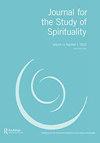苏菲转向和神圣空间的灵性
IF 0.7
0 RELIGION
引用次数: 0
摘要
摘要苏菲主义是伊斯兰教的神秘维度,长期以来一直包含在其sema/sama(崇拜仪式)中,即生动的实践和表演,尤其是使用声音和动作来表达精神状态,这不受更传统/传统的伊斯兰教教派的青睐。苏菲鼓励歌曲和圣歌、舞蹈和动作,以及其他展示信仰的展示,作为与神圣交流的狂喜之爱和精神喜悦的明显展示。伊斯兰历史上最著名的苏菲派之一是贾拉鲁丁·鲁米(公元1207-1273年),或者简单地说,鲁米,他创立了一个苏菲教团,被普遍称为旋风Dervishes。托钵僧坚持一种冥想练习,鲁米鼓励这种练习作为sema/sama的一部分,即旋转或转身的“舞蹈”。苏菲转向是对dhikr的虔诚表达,是对上帝的怀念和沉思。这篇文章讨论了故意构造的苏菲身体(头、手、手臂、躯干)的着迷旋转如何将世俗/世俗的地方转变为与神圣的神秘相遇的空间,因为托钵僧围绕着将苏菲与安拉联系在一起的无形轴线连续旋转。本文将以如米的诗文为切入点,阐释从不确定的地方到神圣空间的转变。本文章由计算机程序翻译,如有差异,请以英文原文为准。
Sufi turning and the spirituality of sacred space
ABSTRACT Sufism, the mystical dimension of Islam, has long included in its sema/sama – the worship ceremony – animated practices and performances, notably the use of sound and movement to express spiritual states, which is not favored by more traditional/conventional denominations of Islam. Sufis encourage song and chant, dance and movement, and other demonstrative exhibitions of faith, as palpable demonstrations of ecstatic love and spiritual joy in communion with the Divine. One of the most notable Sufis in the history of Islam is Jalaluddin Rumi (CE 1207–1273) – or, simply, Rumi – who founded a Sufi order known popularly as the Whirling Dervishes. The dervishes adhere to a meditative practice that Rumi encouraged as part of the sema/sama, the ‘dance’ of whirling, or turning. Sufi turning is a devotional expression of dhikr, the remembrance and contemplation of God. This essay discusses how the entranced spinning of the deliberately structured Sufi body (head, hands, arms, torso) can transform a secular/profane place into a space of mystical encounter with the Divine as the dervish whirls in continuous circles around the invisible axis that binds the Sufi to Allah. The essay will draw on the poetry and prose of Rumi to illustrate the transformation of indeterminate place to sanctified space.
求助全文
通过发布文献求助,成功后即可免费获取论文全文。
去求助
来源期刊

Journal for the Study of Spirituality
RELIGION-
CiteScore
2.50
自引率
7.10%
发文量
25
期刊介绍:
Journal for the Study of Spirituality is a peer-reviewed journal which creates a unique interdisciplinary, inter-professional and cross-cultural forum where researchers, scholars and others engaged in the study and practices of spirituality can share and debate the research, knowledge, wisdom and insight associated with spirituality and contemporary spirituality studies. The British Association for the Study of Spirituality (BASS) organises a biennial international conference and welcomes enquiries about membership from those interested in the study of spirituality in the UK and worldwide. The journal is concerned with what spirituality means, and how it is expressed, in individuals’ lives and communities and in professional practice settings; and with the impact and implications of spirituality in, and on, social policy, organizational practices and personal and professional development. The journal recognises that spirituality and spiritual values can be expressed and studied in secular contexts, including in scientific and professional practice settings, as well as within faith and wisdom traditions. Thus, Journal for the Study of Spirituality particularly welcomes contributions that: identify new agendas for research into spirituality within and across subject disciplines and professions; explore different epistemological and methodological approaches to the study of spirituality; introduce comparative perspectives and insights drawn from different cultures and/or professional practice settings; aim to apply and develop sustained reflection, investigation and critique in relation to spirituality and spiritual practices; critically examine the values and presuppositions underpinning different forms of spirituality and spiritual practices; incorporate different forms of writing and expressions of spirituality.
 求助内容:
求助内容: 应助结果提醒方式:
应助结果提醒方式:


